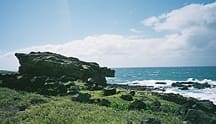Kaʻena Point – Seabird Sanctuary (Natural Area Reserve)
As we began our early ascent up the leeward coast, the Waianae mountains rose overhead, casting shadows that stained the ocean black. We were only 20 minutes from the harbor, and with about 5 miles still ahead of us, I began to get excited about what we would see.
A half hour later and we were nearing the beautiful and isolated Yokohama Bay. Kaena Point lay just ahead. Just as the native Hawaiians believed that Kaena Point was the soul’s departing place from the physical world, we were now migrating from the comfort of solid landmass. Beyond Kaena Point was the seemingly endless ocean. There was no escaping it. Even if you were to close your eyes for the rest of the journey, the rocking would be a reminder. There was an entire universe below our vessel. We are never really alone or isolated per se.
White water exploded against the rocky shore of the raised sand dune. Basalt climbed out of the deep ocean and led to the dramatic, volcanic peaks forming the pennisula,
On land, albatross are very awkward and often have difficulty taking off and landing. This has gained them the nickname of “Goony Bird”. Although albatross are so awkward on land, they are graceful and impressive in flight. An albatross in flight can be so perfectly attuned to wind conditions that it may not flap its wings for hours, or even for days, as it can sleep while flying. It takes advantage of the air currents just above the ocean’s waves to soar in perpetual graceful motion.
Albatross are so beautiful in the air that superstitious sailors believed they were the reincarnated spirits of dead sailors who were searching the oceans for their lost friends. Albatross can be seen nesting at Ka’ena Point, or on our ocean wildlife tours during the winter months.
Ka’ena Point

The Legend of Kaena Point
On the northwestern coast of Oahu is a point of land called ‘Kaena Point.’ Nearby is a huge boulder called ‘Pohaku o Kauai’ or ‘Rock of Kauai.’ Legend has it that both of these landmarks came to be because of the actions of one man on a dark, stormy night many years ago.
On this night, when the wind raged, lightning struck, thunder rumbled and the rain beat down from the heavens upon the islands of Hawaii, a baby boy was born. The storm was so vicious that the unrelenting rain that fell from the black clouds washed the red soil down through the valleys and soon the flooded streams and thundering waterfalls churned as red as blood.
As the storm raged on, a rainbow appeared above the house in which the baby was born. It was still there the next day when the storm died down, the sky cleared and the sun came out. It was thought that the child was special, and that rainbow was a sign of his power.
The boy was named Haupu. He displayed incredible strength at an early age and eventually grew to be a brave and powerful warrior. He was known throughout the islands – respected for his amazing strength, but feared for his quick temper.
One night, Kaena, an Oahu chief, organized a night-fishing expedition. He gathered many people from the village and they set out in canoes of all sizes, with torches and their largest fishing nets.
This same night, Haupa was sleeping in his royal home on Kauai, some thirty miles (48 km) from Oahu. He awoke to strange noises out on the water, and when he looked out he saw faraway lights dancing in the black distance. Half asleep, Huapu imagined a group of warriors coming from Oahu to attack his people, and so he rushed to the edge of a nearby cliff, heaved up a huge boulder, and flung it out across the channel between the two islands.
The canoes were smashed and shattered into tiny pieces, and Chief Kaena, who stood proudly in the middle of his people, lost his life along with many of the fishermen. The boulder hit the water with such force that the resulting waves washed huge amounts of sand onto the shore, forming a point of land.
The survivors of the disastrous fishing expedition made their way back to the shore of Oahu, and thereafter named the cape ‘Kaena’ after their fallen chief. The boulder, they named the Rock of Kauai.
Laysan Albatross walking at Kaena Point
March 2010 Hawaii vacations: Top whale-watching tours | Orbitz Blog Hawaii’s marine scene gets a little more crowded each winter, as thousands of North Pacific humpback whales migrate 3,500 miles from Alaska to the warm South Pacific waters. “For a small-craft whale-watching experience on your Hawaii vacation, locals recommend Wild Side Specialty Tours. There’s an educational element to the excursions, which are typically led and narrated by marine biologists. Observation easily intensifies into actual conservation research if that’s something that interests you. Excursions head out to Oahu’s west coast, particularly off Kaena Point.”
